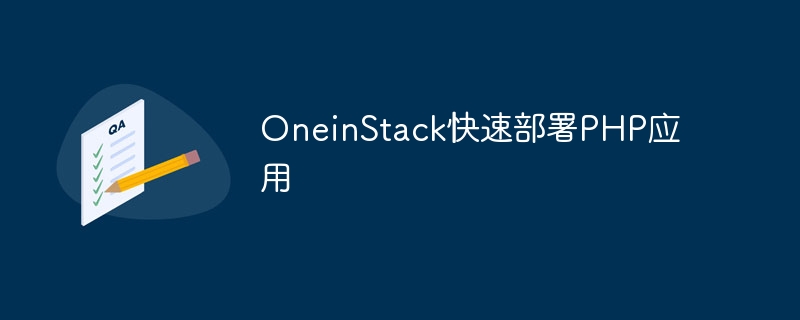Home >Backend Development >PHP Tutorial >OneinStack quickly deploys PHP applications
OneinStack quickly deploys PHP applications
- PHPzOriginal
- 2024-03-11 10:03:031081browse

OneinStack quickly deploys PHP applications and requires specific code examples
With the continuous development of the Internet, more and more people are paying attention to how to quickly deploy PHP applications. As an automated deployment tool, OneinStack can help users quickly set up a PHP environment and deploy applications. This article will introduce the basic usage of OneinStack and give specific code examples to help readers understand how to use OneinStack for PHP application deployment.
1. Introduction to OneinStack
OneinStack is an automated deployment tool based on LNMP, LNMPA, LAMP, and LNMP one-click installation packages. OneinStack can be used to quickly deploy Nginx, MySQL/MariaDB, PHP, Redis and other services, and is suitable for the deployment of various PHP applications. OneinStack provides a wealth of functions and options, can be customized and configured according to user needs, supports multiple versions of PHP and MySQL, and is simple, fast, and stable.
2. OneinStack installation steps
- Download and decompress the OneinStack compressed package:
wget http://mirrors.linuxeye.com/oneinstack-full.tar.gz tar xzf oneinstack-full.tar.gz cd oneinstack
- Execute the installation script:
./install.sh
- Configure according to the prompts, including selecting the installation version, setting the administrator password, etc.
- After the installation is complete, you can view the detailed information of PHP by accessing http://serverIP/phpinfo.php through your browser.
3. OneinStack Deployment PHP Application Example
Next, we will take the deployment of a simple PHP application as an example to demonstrate how to use OneinStack for deployment.
- Create a directory named test to store our application files:
mkdir /data/wwwroot/test cd /data/wwwroot/test
- Create a simple PHP file index.php and add Its content is set to:
<?php echo "Hello, OneinStack!"; ?>
- Configure the Nginx site file. You can use vim or other editors to open the Nginx configuration file:
vim /usr/local/nginx/conf/vhost/test.conf
in test.conf In the file, set the Nginx virtual host configuration as follows:
server {
listen 80;
server_name test.com;
root /data/wwwroot/test;
index index.php index.html index.htm;
location ~ .php$ {
fastcgi_pass unix:/tmp/php-cgi.sock;
fastcgi_index index.php;
include fastcgi.conf;
}
}- Modify the host file and add a line:
echo "127.0.0.1 test.com" >> /etc/hosts
- Restart the Nginx service:
/usr/local/nginx/sbin/nginx -s reload
- Visit http://test.com/index.php and you can see the output of "Hello, OneinStack!", indicating that the PHP application is deployed successfully.
Through the above example, we demonstrate how to use OneinStack to quickly deploy PHP applications. As a powerful automated deployment tool, OneinStack can greatly simplify the deployment process and save time and energy. I hope the content of this article can help readers better understand the use of OneinStack and how to deploy PHP applications in actual applications.
The above is the detailed content of OneinStack quickly deploys PHP applications. For more information, please follow other related articles on the PHP Chinese website!

